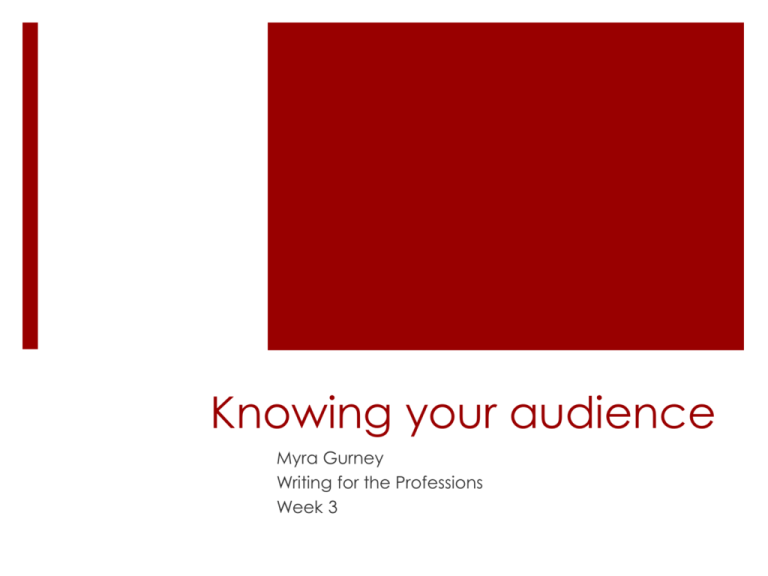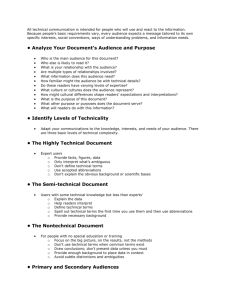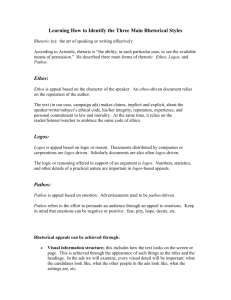Week 3 Lecture Slides
advertisement

Knowing your audience Myra Gurney Writing for the Professions Week 3 Why is understanding the audience important? “The writer frequently takes too much for granted, assuming that merely by speaking his mind he can change the reader's. If he fails, however, to utilise available bridges to to create new ones, his writing will not be effective. Thus it is not enough that bridges exist; they must be used – and therein lies much of the art of rhetoric.” From Young, Becker and Pike (1970, 172 cited in Schriver, 1997, 163). Remember the communication process Context Purpose Writer Document Reader Outcome Who are our readers? Questions to consider What key things don’t they know? How great is your readers’ technical knowledge or how much relevant background knowledge do they have about the topic of your brochure? Do your readers have any communication preferences you should take into account? Where and how will your readers use the document? What is the rhetorical approach? Karen Schriver (1997) says it is the dominant approach for teaching of professional writing and document design Originated with Aristotle’s “The Rhetoric”, a primer on public speaking Three main dimensions: Ethos, Pathos, Logos Ethos Ethos is an appeal based on the character of the speaker. An ethos-driven document relies on the reputation and credibility of the author. Spelling mistakes can ruin this appeal. Pathos Pathos is an appeal based on emotion. Advertising tends to be pathos-driven. Use of motive appeals such as appealing to the family, loved ones, the community, global peace, sex and money are examples. Logos Logos is an appeal based on logic or reason. Documents distributed by companies or corporations are logos-driven, eg company reports. Scholarly documents are also mainly logos-driven. Different reasons people read … according to Schriver, 1997,171 Reading to enjoy – characterised by the satisfaction that people get by interacting with the text, the pleasure of engaging with the content eg novels, stories, poems, magazines, newspapers Reading to assess – characterised by the goal of evaluating the relevance or value of the document’s content before committing to read it eg marketing/letterbox brochures, business correspondence, reports, catalogues etc Different reasons people read … according to Schriver, 1997,171 Reading to learn – characterised by the intention of using a document in order to perform a task eg instruction manuals, forms, employee handbooks, online help, bus schedules, cookbooks Reading to learn to do – characterised by engaging with the content in order to acquire background knowledge needed in order to do something else eg studying a textbook Professional analysis of audiences You need to research your audience’s needs. Survey, interview, observation. There may be more than one audience; documents may be filed away to be taken out much later on. Audiences change. Real audiences vs potential audiences Everyday analysis of audiences We all try to second guess what our intended audience really requires We imagine our audience reading our documents and try to satisfy them We guess their informational needs, their preferences for design, their appreciation of our choice of fonts 1 7 Ask the readers what they want and how they will use the text How will you use this, what do you want? Do people really know this? Use open-ended questions Likert scales Information preferences – text style, graphics Show them different styles Answers not generalisable between different audiences 1 8 Evaluate reader’s attitudes Hostile or favourable to your message Do you need to use strong argument? Mindset towards the task, the organisation, the message Avoid a totally expert or alienating tone of voice which may put people off – how will people react to the language you use? Preferred communication style Brevity vs detail Text vs graphics Drawings vs photographs Formality vs informality Often shaped by organisational or corporate culture Two methods Brainstorm ideas – work out possible questions, answers, forwards, backwards, contents, index? Just ask them or ask other professionals in the field. E.g. Floreak (1989) used a pre-design audience analysis of 25 low literate parents. Used open ended questions, Likert scales and observation to show audience preferences. Audience attitudes Need to consider the audience’s standpoint Manuals are the last resort, after frustration and friends fail (RTFM motto) Is the audience hostile towards the document? E.g. giving a presentation on a politically insensitive topic Audience roles What kinds of roles do audience members adopt? Decision makers, Advisers, Consultants, Implementers? Often a person might adopt all these roles What communication style will suit the reader? Brevity, summaries, fonts, colour, formality? Company culture Much of the individual preferences will be shaped by the corporate culture Locate other company documents – reports, advertising brochures – mimic or depart from this image UWS’s changing image of itself Changing online opinions of what makes a good website 2 6 Language Warning: Close your eyes if you are easily offended Different approaches for different readers – the case of Venus & Mars Different approaches for different readers – the case of Venus & Mars






